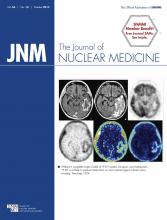TO THE EDITOR: The recent study by Weber et al. (1) addresses standardized uptake value (SUV) quantification repeatability in 2 multicenter trials of non–small cell lung cancer and reports repeatability coefficients of −28%/+39% and −35%/+53% for SUVpeak. No clear correlation was found between SUV test–retest variability and any of several considered parameters (body weight, age, clinical stage, blood glucose level, uptake time). We would like to draw attention to another possible explanation, namely interscan variation of the arterial blood SUV.
In a previous publication (2), we demonstrated a distinctly improved linear correlation between tumor-to-blood SUV ratio (SUR) and Km, the metabolic rate of 18F-FDG, in comparison to SUV versus Km correlation. In a later publication (3), we provided strong evidence that SUR possesses a distinctly improved prognostic value in comparison to SUV.
Our results, together with other data (4,5), support the notion that SUV normalization (either to body weight or lean body mass) does not reduce interscan blood SUV variability below 20%–30% (single SD). This implies an equally large test–retest variability of SUV parameters (SUVpeak, SUVmean, SUVmax) since tracer uptake is proportional to the scaling of the arterial input function. This variability can be eliminated by replacing SUV by SUR, that is, by normalizing tumor SUV to arterial blood SUV.
Weber et al. (1) did not detect a notable influence of uptake time differences on the SUV variability coefficients although irreversible binding of 18F-FDG will cause continuously increasing SUVs over time in the presence of nonnegligible residual blood SUVs. We have quantitatively investigated this effect and were able to demonstrate that a variation in uptake time from T0 to T might be corrected approximately (6) according to SUV0/SUVT ≈ (T0/T)1-b, where b ≈ 0.31 is determined by the given (essentially invariant) shape of the arterial input function. Since Table 1 of the present paper yields some 15%–20% (SD) uptake time variability for the respective scan groups in both trials, one arrives at roughly 12% SUV variability (SD). Together with a conservative low estimate of 22% for the variability of tracer supply (blood SUV), one then can estimate by gaussian error propagation that both (uncorrelated) effects lead to a cumulative variability of about ΔSUV/SUV ≈ √(222 + 122) ≈ 25%. Since the uptake time variability is moderate in the investigation of Weber et al., the predicted tumor SUV variability is thus mostly due to interscan blood SUV variation, which might explain that the uptake time effect alone does not clearly manifest itself in the investigation of Weber et al.
Overall, comparing the 25% estimate given above with the actual SUV variability reported by Weber et al., we conjecture that a large part of the observed variability might be a consequence of blood SUV variability (plus an additional component due to uptake time variability). On top of this approximately 25% effect, other factors are operational such as imperfect scanner calibration and inaccuracies of body weight and dose information (all of which should also be accounted for when moving from SUV to SUR since they cancel out from the ratio computation).
If our conjecture is correct, one would expect that the test–retest stability of tracer uptake quantification would be distinctly improved if instead of SUV the SUR corrected for uptake time were used. SUR (which equals the left-hand side of the Patlak equation) can be shown to have a better linear correlation to Km than SUV theoretically as well as experimentally (2), which has rather obvious consequences for the prognostic value of both quantities (3). We would therefore find it highly desirable to test the hypothesis of superior performance of SUR in the valuable data of Weber et al. This could be done retrospectively by performing an image-based determination of the blood SUV in a suitable 3-dimensional region of interest placed in the aorta.
Footnotes
Published online Jun. 25, 2015.
- © 2015 by the Society of Nuclear Medicine and Molecular Imaging, Inc.







